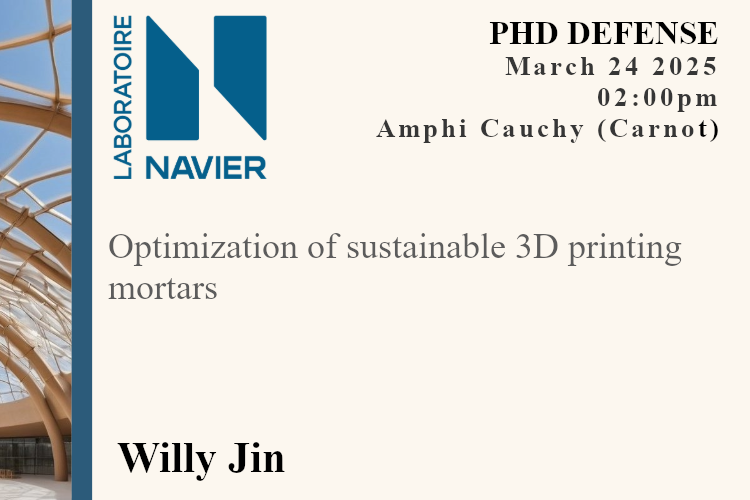
PhD Defense – Willy Jin
- Post by: sebastien.gervillers
- 21 March 2025
- No Comment
Willy Jin, a PhD candidate in the Architectured Materials and Structures team and École de Technologie Supérieure of Université du Québec will defend his dissertation titled « Optimization of sustainable 3D printing mortars » on Monday, March 24 at 2:00 PM in the Cauchy amphitheater. (Carnot)
Composition of the jury :
- Alexandre PIERRE – Lecturer, CY Université Cergy (Reviewer)
- Nordine LEKLOU – Professor, Université d’Orléans (Reviewer)
- Lucas HOF – Associate Professor, École de Technologie Supérieure (Examinator)
- Sébastien RÉMOND– Professor, Université d’Orléans (Examinator)
-
Claudiane OUELLET-PLAMONDON – Professor, École de Technologie Supérieure (Thesis Co-Director)
-
Jean-François CARON – Professor, École Nationale des Ponts et Chaussées (Thesis Co-Director)
- Charlotte ROUX – Researcher, Mines PSL (Thesis Supervisor)
- Nicolas DUCOULOMBIER – R&D expert, XtreeE (Guest)
The defense will be broadcasted live
Abstract
Climate change is compelling the entire construction industry to adopt more sustainable practices. This thesis contributes to the ongoing industrialization of the sector, which must be concurrent with a reduction in its environmental footprint.
Extrusion‑based 3D printing is rapidly advancing in both academic and industrial fields, showcasing significant technical progress throughout the process. However, mix design strategies for materials that meet the rheological requirements of these systems are still lacking, particularly when it comes to alternative binders. Yet, one of the most promising avenues for achieving substantial decarbonization (over 30%) in 3D printing lies in optimizing mortar constituents and proportions, thus maximizing strength per unit volume of cement, knownto be the primary contributor to greenhouse gas emissions in mortars. In this context, mix design procedures tailored specifically to 3D printing must be explored, with a strong emphasis on environmental performance.
This thesis introduces two optimization strategies for mortars with very low cement content. The first approach associates a contextualized life cycle assessment model with the prediction abilities of artificial neural networks for the multi‑objective optimization of a mortar containing threetypes of supplementary cementitious materials. The second approach utilizes a granular packing model to guide the design of LC3‑type mortars, destined for acceleration with aluminium sulfates. This provides a critical analysis of the pozzolanic contribution of calcined clay in regard to its negative effect on overall packing density across various application ranges.
Finally, this research highlights the largely unexplored potential of ternary and quaternary binders for sustainable 3D printing.


